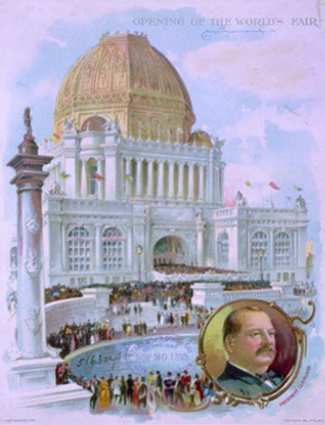Quick List Info

Dates Open - May 1 to October 30, 1893. 179 days open to public, including all Sundays, except 4 - May 7, 14, 21 & July 23. (Those 4 were open to exhibitors, passholders, etc., amounting to a total of only 27,144 visitors).
Attendance - 21,480,140 Paid; 27,539,521 Total.
International Participants - 50 Nations and 26 Colonies.
Total Cost - $27,291,715. (Total expenditure $28,340,700 less Div.-Chi. $500,000 & Capital stock 10% $548,985 for Actual Expenses of $27,291,715.) U.S. States and Territories spent an additional $6.02 million and Foreign Exhibitors $6 million.
Site Acreage - 686.1 acres in what is now Chicago's Jackson Park.
Sanction and Type - Prior to the Bureau of International Exhibitions. Would be considered a Universal style Registered event today like those on the 0 years of the decade. Act of Congress provided that the President of the U.S. would issue a proclamation of time and place and extend invitations to foreign nations to participate in the World's Columbian Exposition.
Ticket Cost - Various different types of tickets were used, including Souvenir Tickets (4 designs, Columbus, American Indian, Washington, Lincoln: 6 million ordered, good for any day). Plain Tickets (good only on date of sale) 25 million ordered. Passes for free admissions, including photo pass, complimentary card of admission to high dignitaries, workmen's passes (good for 1 month), return checks were used for those with passes who had to leave and re-enter the grounds each day. Daily ticket 50 cents. After May 22, a children's ticket (age 6-12, under 6 free) cost 25 cents. Later, during October 10-21, children from 6-18 admitted for 10 cents. Originally gates were open from 8 a.m. to 7 p.m., extended to open 7:30 a.m. to 11 p.m.

Photo top center: Lithograph of the World's Columbian Exposition grounds, 1892, Winters Art Lithograph Company. Column Top: Opening of the World's Fair lithograph with Grover Cleveland image insert, 1893, The Knapp Company Lithograph. Photo bottom: Mining Building, 1893, Souvenir Photo Company. Images courtesy Library of Congress.

Other Histories of World's Fairs to Check Out










